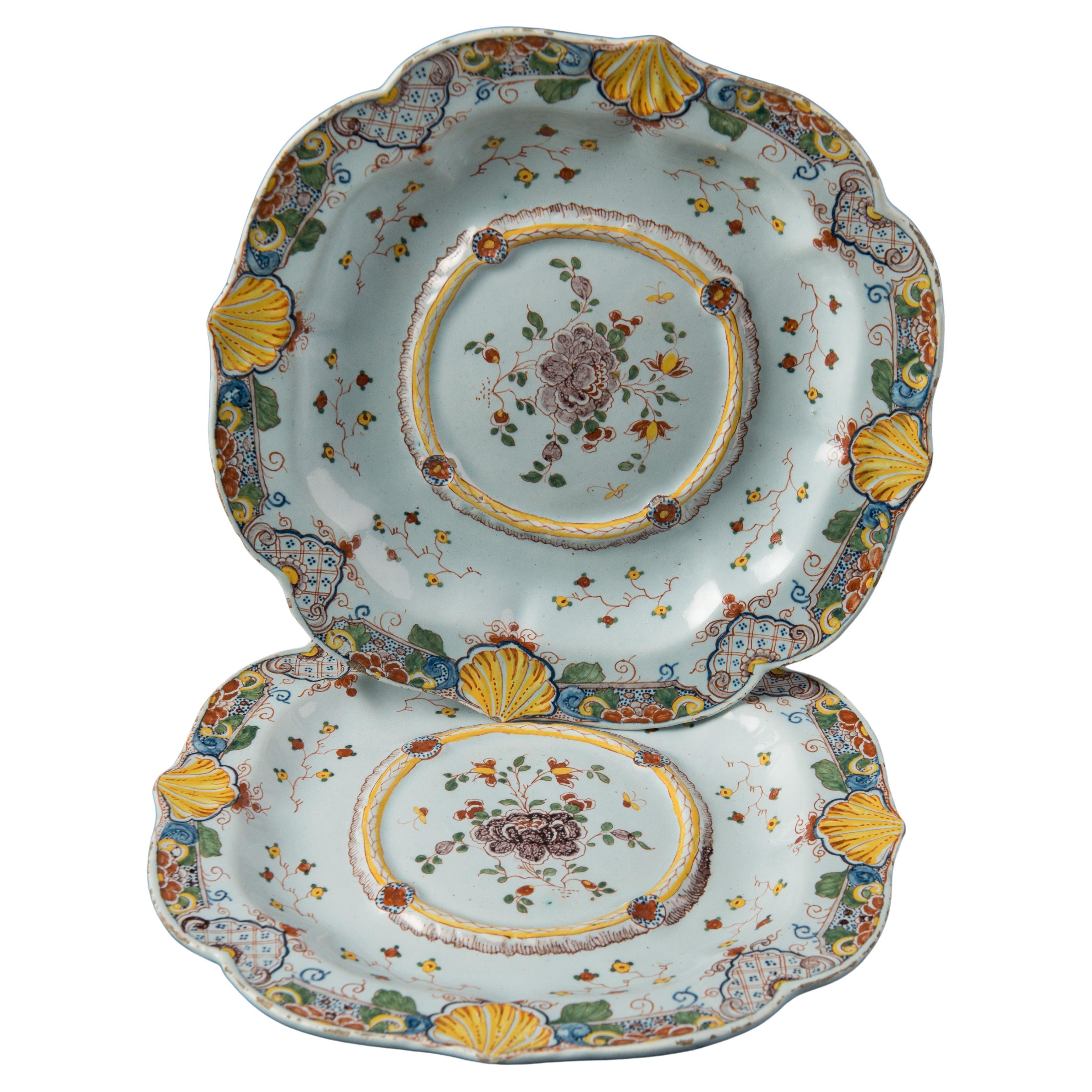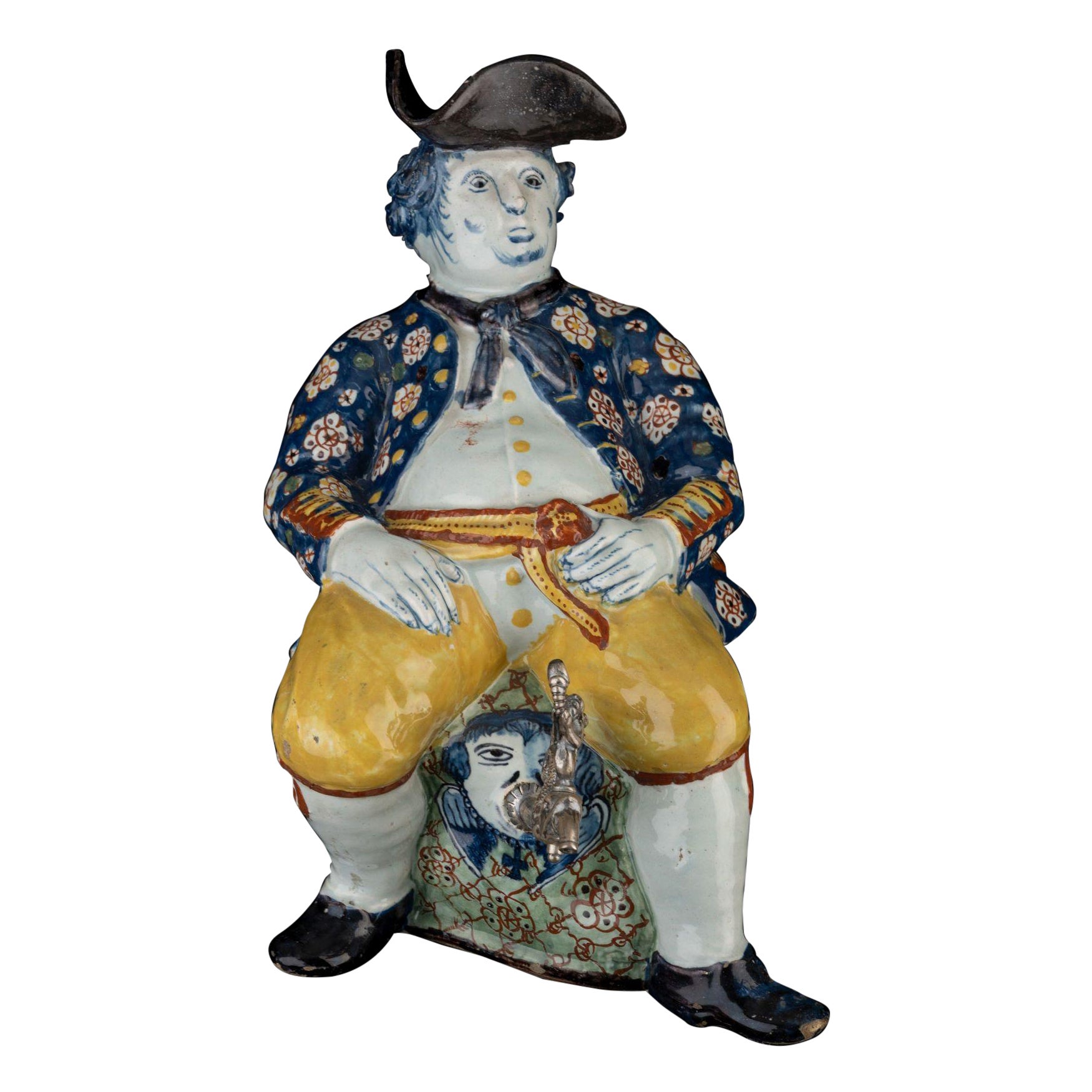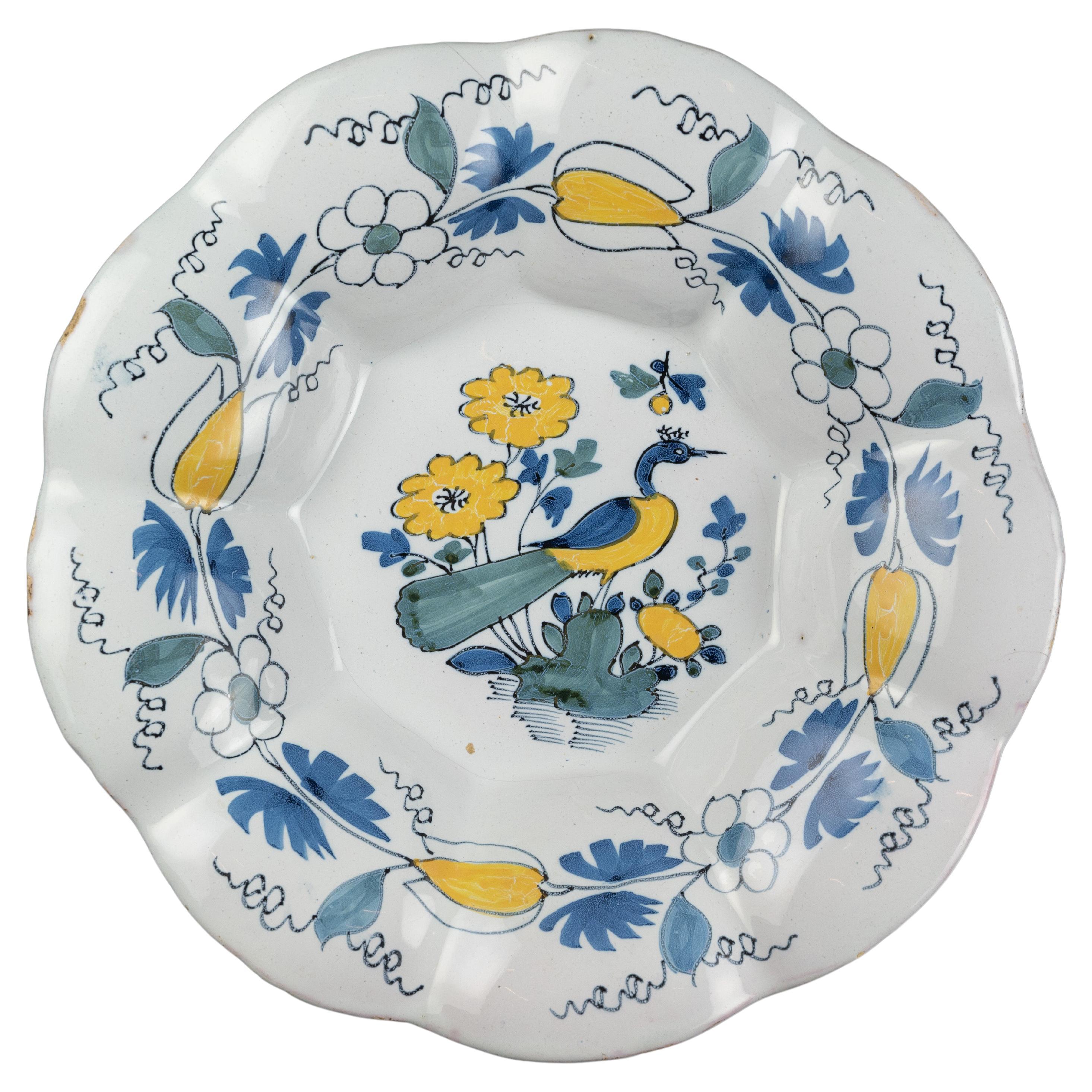Items Similar to Polychrome Imari Cooler, Delft, 1713-1735, Mark: Ar for Adriaan Van Rijsselbergh
Video Loading
Want more images or videos?
Request additional images or videos from the seller
1 of 14
Polychrome Imari Cooler, Delft, 1713-1735, Mark: Ar for Adriaan Van Rijsselbergh
About the Item
Polychrome Imari cooler. Delft, 1713-1735
Mark: AR Painter: Adriaan van Rijsselbergh
This oval ribbed cooler stands on three pyramid-shaped feet and is painted in a six-coloured Imari palette. The exterior is decorated with two round medallions filled with gilded floral motifs on an iron-red ground. Gilded blue leafy motifs are applied to the upper side of the medallions, gilded blue rocky motifs to the underside. On either side rocks, prunus, vegetation, birds and insects are depicted. The embossed upper rim is alternately decorated with trellis diaper and small red flowers.The two twisted horizontal handles are dotted in blue, red and gold. The interior is painted with an Oriental garden landscape depicting a phoenix on a prunus branch, flowers, plants and two fences. Two flowering prunus branches are painted on the inner side.
In 1713 Adriaan or Ary van Rijsselbergh (1689?-1735), together with three others, was employed as a gold painter by the widow Johanna Kocx - Van der Heul, owner of The Greek A pottery in Delft (Eliëns, p. 69). A gold painter was a specialist in painting petit feu decors in the Japanese Imari and Kakiemon styles. There was a huge demand for these porcelain types which were copied on a large scale in Europe. In the Dutch republic The Greek A was the most prominent manufacturer of Imari and Kakiemon decors. The pottery excelled in this production, not least thanks to the input of the hired gold painters.
The contract that Van Rijsselbergh signed with the widow in 1713, remained valid as long as Johanna van der Heul remained owner of The Greek A pottery. She sold the pottery in 1722 to Jacob van der Kool. Whether this contract was terminated or extended, is not known. Perhaps the success of this gold-painted pottery encouraged Van Rijsselbergh to paint on his own account, or he was allowed to work partly for himself. His estate inventory, drawn up in 1735, shows that he possessed in his basement, besides Delftware, large quantities of the same kind of Asian porcelain (Eliëns, p. 133 and 136). It is very likely that he had a petit feu kiln at home in which he fired pieces he had painted.
The condition is exceptionally good considering age of 300 years. small chips to glaze of rim and handles. There is a hairline crack under the decoration of branches with leaves on the inside wall. This is caused during production.
- Creator:Delft (Maker)
- Dimensions:Height: 3.93 in (9.99 cm)Width: 8.46 in (21.49 cm)Depth: 11.81 in (30 cm)
- Style:Baroque (Of the Period)
- Materials and Techniques:
- Place of Origin:
- Period:
- Date of Manufacture:1725
- Condition:Wear consistent with age and use. The condition is exceptionally good considering age of 300 years. small chips to glaze of rim and handles. There is a hairline crack under the decoration of branches with leaves on the inside wall. This is caused during production.
- Seller Location:Verviers, BE
- Reference Number:1stDibs: LU1441227212102
About the Seller
4.9
Platinum Seller
These expertly vetted sellers are 1stDibs' most experienced sellers and are rated highest by our customers.
Established in 2000
1stDibs seller since 2015
697 sales on 1stDibs
Typical response time: 2 hours
- ShippingRetrieving quote...Ships From: Velddriel, Netherlands
- Return PolicyA return for this item may be initiated within 3 days of delivery.
More From This SellerView All
- Polychrome Chinoiserie Bowl, Delft, 1710-1730By DelftLocated in Verviers, BEPolychrome chinoiserie bowl. Delft, 1710-1730 This polychrome bowl stands on a high foot and has three extra feet. The two angular handles are ver...Category
Antique Early 18th Century Dutch Baroque Delft and Faience
MaterialsFaience, Ceramic
- Polychrome Chinoiserie Wine Jug, Delft, circa 1680By DelftLocated in Verviers, BEThe polychrome wine jug has an ovoid body on a low spreading foot, a conical neck with spout and a handle with a scroll finish. The jug is painted in purple, yellow and green with a continuous chinoiserie landscape with three Chinese figures. A band with scroll ornaments and circles is applied to the shoulder just below the neck, the neck itself is decorated with two stylized flowers and scroll ornaments. The handle is decorated with stripes and scroll ornaments. Dimensions: height 19 cm / 7.48 in. Multi-coloured chinoiserie landscapes on Delftware were only made for a short period of time, roughly between about 1680 and 1690. Most of the decors have been applied on dishes, lobed dishes, butter pots...Category
Antique Late 17th Century Dutch Baroque Ceramics
MaterialsCeramic
- Polychrome Chinoiserie Wine Jug with Turned Body, Delft, circa 1680By DelftLocated in Verviers, BEPolychrome chinoiserie wine jug. Delft, circa 1680 The polychrome wine jug has an ovoid and turned body on a low spreading foot, a conical neck with spout and a handle with a scroll finish. The jug is painted in blue, purple and green with a continuous chinoiserie landscape with three Chinese figures. Bands with rectangular ornaments between double circles are applied on the shoulder and just above the foot. The neck is painted with a double leaf motif. The handle is decorated with stripes and scroll ornaments. Dimensions: height 23 cm / 9.05 in. Multi-coloured chinoiserie landscapes on Delftware were only made for a short period of time, roughly between about 1680 and 1690. Most of the decors have been applied on dishes, lobed dishes, butter pots...Category
Antique Late 17th Century Dutch Baroque Ceramics
MaterialsCeramic
- Fine Dutch Delft Polychrome Charger, 1750-1800By Dutch OriginalsLocated in Verviers, BEDutch delftware charger, 1750-1800. The decoration is a stylised version of an oriental garden on 17th century Chinese porcelain. Dime...Category
Antique Late 18th Century Dutch Baroque Ceramics
MaterialsCeramic, Delft, Faience
- Sitting Dog, Delft, circa 1740By DelftLocated in Verviers, BEThe molded dog is sitting on a rectangular base and has its head raised and turned, and his snout opened. He wears a red-dotted collar. The dog is painted in blue, the stand in blue ...Category
Antique Mid-18th Century Dutch Baroque Delft and Faience
MaterialsCeramic, Faience
- Blue and White Marriage Plate, Delft, Dated 1759By DelftLocated in Verviers, BEBlue and white marriage plate. Delft, dated 1759 The marriage plate is painted in blue with a crowned shield between two laurel wreaths. The shield i...Category
Antique Mid-18th Century Dutch Baroque Ceramics
MaterialsCeramic, Faience
You May Also Like
- Delft, 1725-1750 a Pair of Polychrome Stands for Butter DishesBy DelftLocated in ROSSUM, GEThe mainly square-shaped stands have indented corners and a raised center section with rim and four small flowers. The stands are painted in polychrome with a combination of flowers,...Category
Antique Mid-18th Century Dutch Baroque Ceramics
MaterialsCeramic, Faience
- Polychrome table fountain Delft, 1750-1770By DelftLocated in ROSSUM, GEPolychrome table fountain Delft, 1750-1770 The polychrome table fountain is modelled in the form of a corpulent, seated man on a pedestal. He sits leisurely leaning back on a green pedestal with net decor with flowers. He is dressed in a blue jacket with flowers, white vest, yellow knee-breeches, white stockings and dark shoes. On his head he wears a tricorn that has an opening at the top for liquor (wine, liqueur or gin) for liquor to be poured into. The stopper is missing. There is a handle on the back, and a pewter tap in a mascaron on the front. Dimensions: height 31,5 cm / 12.40 in., width 21 cm / 8.26 in., depth 29,5 cm / 11.61 in. Provenance: G. Lefebvre, antique dealer in Paris...Category
Antique Mid-18th Century Dutch Baroque Ceramics
MaterialsCeramic, Faience
- Polychrome Lobed Dish with Horseman Delft, 1690-1700By DelftLocated in ROSSUM, GEPolychrome lobed dish with horseman. Delft, 1690-1700. Dimensions: diameter 33,8 cm / 13 in. The lobed dish is composed of twenty-seven double lobes and is painted in polychrome with a central motif of a horseman. The border is decorated with a continuous frieze of simplified flowers and tulips. The horseman is standing on a green ground between two trees. This type of decoration harks back to maiolica plates...Category
Antique Late 17th Century Dutch Baroque Delft and Faience
MaterialsCeramic, Faience
- Polychrome Lobed Dish with Peacock. Delft, circa 1680By DelftLocated in ROSSUM, GEPolychrome lobed dish with peacock. Delft, circa 1680 Dimensions: diameter 34,7 cm / 13.66 in. The polychrome lobed dish is composed of nine wide lobes...Category
Antique Late 17th Century Dutch Baroque Delft and Faience
MaterialsCeramic, Faience
- Delft Polychrome Dish with a Village View the Netherlands, 1675-1725By DelftLocated in ROSSUM, GEPolychrome dish with a village view The Netherlands, 1675-1725. The dish has a spreading, slightly raised flange and is painted in blue, purple and yellow with a simplified villag...Category
Antique Early 18th Century Dutch Baroque Delft and Faience
MaterialsCeramic, Majolica
- Polychrome Lobed Dish with Peacock in Landscape, Delft, circa 1690By DelftLocated in ROSSUM, GEPolychrome lobed dish with peacock in landscape. Delft, circa 1690. Dimensions: diameter 34,9 cm / 13.74 in. The polychrome lobed dish is composed of nine wide lobes and is pain...Category
Antique Late 17th Century Dutch Baroque Delft and Faience
MaterialsCeramic, Faience
Recently Viewed
View AllMore Ways To Browse
Antique Ceramics Marks
Marks On Antique Glass
Antique Signs For Kitchen
Sign Up For Account
Antique Silver European Silver Marks
Antique European Silver Marks
Large Delft
18th Century Firing Glass
Delft Hand Painted In Holland
18th Century Dutch Delft
Birds Under Glass
Antique Delft Porcelain
Antique Delft Pottery Delft
Antique Delft Pottery
Delft Antique Pottery
Delft Pottery Antique
Delft Floral
Large Blue Delft





